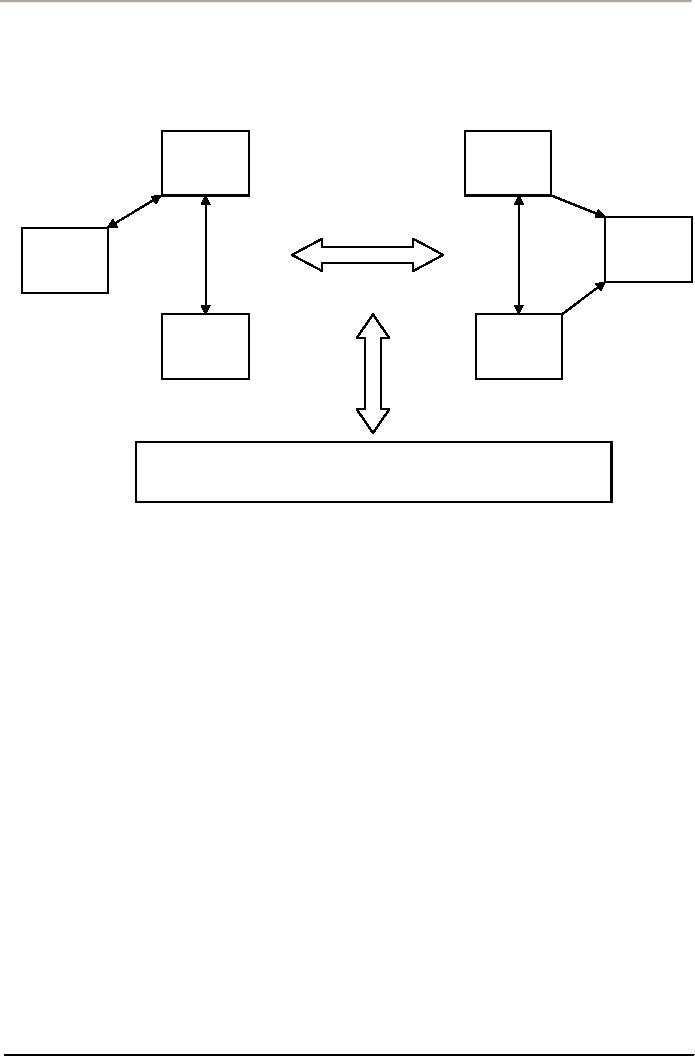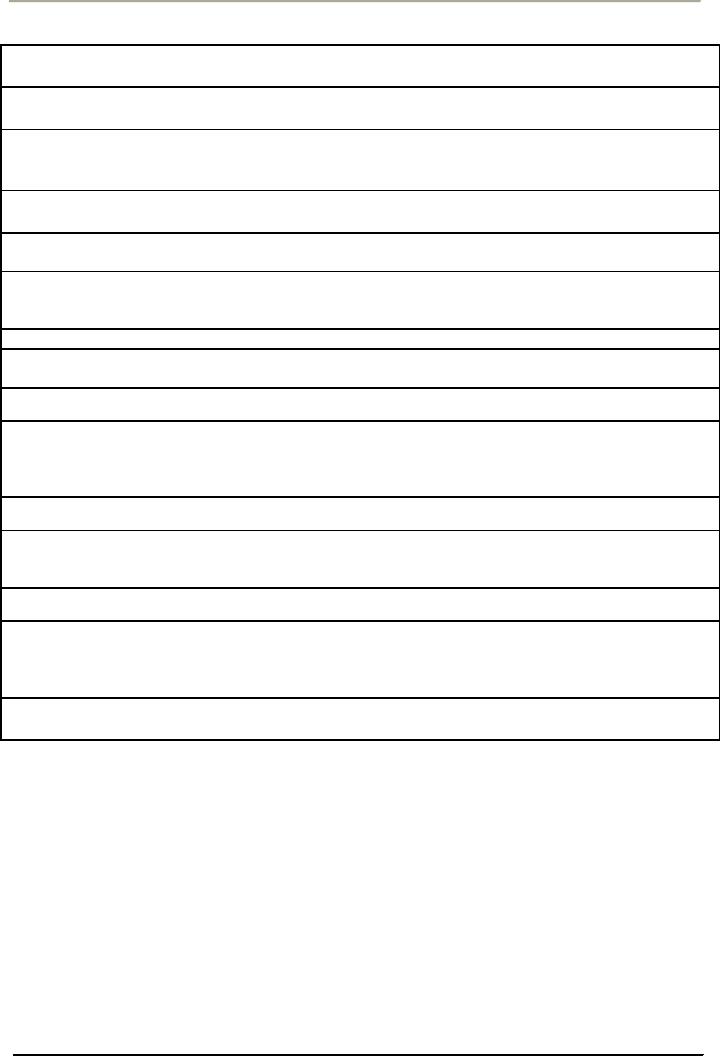 |
BUSINESS EXCELLENCE MODELS:Excellence in all functions |
| << OVERVIEW OF TOTAL QUALITY APPROACHES:The Future of Quality Management |
| DESIGNING ORGANIZATIONS FOR QUALITY:Customer focus, Leadership >> |

Total
Quality Management
MGT510
VU
Lesson
# 20
BUSINESS
EXCELLENCE MODELS
Excellence
starts with
`Marketing'
The
`marketing' function of an organization
must take the lead in
establishing the true requirements
for
the
product or service. Having determined the
need, marketing should
define the market sector
and
demand.
This will determine product
or service features such as the grade, price,
quality, timings,
etc.
For
example, a major hotel
chain, before opening a new
hotel or refurbishing an old one,
will need to
consider
its location and accessibility,
before deciding whether it
will be predominantly a budget,
first
class,
business or family
hotel.
Marketing
will also need to establish
customer requirements by reviewing the
market needs,
particularly
in
terms of unclear or unstated expectations or
preconceived ideas held by customers.
Marketing is
responsible
for determining the key
characteristics which determine the
suitability of the product or
service
in the eyes of the customer. This may, of
course, involve the use of
market research techniques,
data
gathering, and analysis of customer
complaints.
Excellent
communication between customers and suppliers is the
key to total organizational
excellence.
This
will eradicate the `demanding
nuisance/idiot' view of customers,
which pervades some
organizations.
Poor communications often occur in the supply
chain between organizations,
when
neither
party realizes how poor they
are. Feedback from both
customers and suppliers needs to
be
improved,
where dissatisfied customers and
suppliers do not communicate their problems. In
such cases
non-conformance
of purchased products or services is
often due to the customer's inability
to
communicate
their requirements clearly. If these
ideas are also used
within an organization, then
the
internal
supplier/customer interfaces will operate much more
smoothly.
Marketing
must also establish systems
for feedback of customer information and
reaction, which
should
be
designed on a continuous monitoring
basis. Any information pertinent to the
product or service
should
be collected and collated, interpreted,
analyzed, and communicated to improve the
response to
customer
experience and expectations. These same
principles must also be
applied inside the
organization
for continuous improvement at
every transformation process
interface to be achieved. If
one
department has problems recruiting the correct sort of
staff, and `HR' have not
established
mechanisms
for gathering, analyzing, and
responding to information on new
employees, then frustration
and
conflict will replace communication and
co-operation.
Excellence
in all functions
For
an organization to be truly excellent,
each part of it must work
properly together. Each
part, each
activity,
each person in the organization affects
and is in turn affected by others. Errors have a
way of
multiplying
and failure to meet the requirements in
one part or area creates problems
elsewhere, leading
to
yet more errors, yet more problems and so
on. The benefits of getting
it right first time
everywhere
are
enormous.
Everyone
experience almost accepts problems in
working life. This causes
people to spend a
large
part
of their time on useless
activities, correcting errors, looking
for things, finding out
why things are
late,
and checking suspect information,
rectifying and reworking,
apologizing to customers for
mistakes,
poor
quality and lateness. The
list is endless and it is estimated that
about one-third of our
efforts are
wasted
in this way. In the service sector it
can be much higher.
Quality,
the way we have defined it as meeting the
customer requirements, gives people
indifferent
functions
of an organization a common language for
improvement. It enables all the
people, with
different
abilities and priorities, to communicate
readily with one another, in
pursuit of a common goal.
When
business and industry was
local, the craftsman could
manage more or less on his
own. Business is
67

Total
Quality Management
MGT510
VU
now
so complex and employs so many
different specialist skills that
everyone has to rely on
the
activities
of others in doing their
jobs.
Frameworks
for Quality and Performance
Excellence
The
philosophies of Deming, Juran, and
Crosby provide fundamental
principles on which total
quality is
based.
Business firms tend to be
highly individualized. As a result, it is
difficult to apply one
specific
philosophy.
Company leaders must understand the
differences and commonalties in the
three
philosophies
and tailor an approach that fits
their unique culture. Some
of the most successful
firms,
such
as Texas Instruments and Dana Corporation, have done
this. Aspects of implementation
are
addressed
further in chapter 11.
None
of thee philosophies, however,
provide a framework for how
to implement total quality
within an
organization
or a means of assessing total
quality efforts relative to
one's peers or
world-class
companies.
Award criteria and certification
procedures fill this
important role. The two
most prominent
frameworks
for quality that have had
world-wide influence are ISO
9000 and the Malcolm
Baldrige
National
Quality Award
Criteria.
The
Malcolm Baldrige National Quality
Award
In
this section we present an overview of
the Award, the Criteria, and the
Award Process. The
Baladrige
Award
recognizes U.S. companies
that excel in quality
management practice and performance.
The
Baldrige
Award does not exist
simply to practice and performance. The
Baldrige Award does not
exist
simply
to recognize product excellence, nor does
it exist for the purposes of
"winning." Its
principal
focus
is on promoting high-performance
management practices that
lead to customer satisfaction
and
business
results. Up to three companies can
receive an award in each of the categories of
manufacturing,
small
business, service, nonprofit health
care, and nonprofit education.
Health care and education
award
categories
were established in 1999.
The
purposes of the award are to
·
Help
stimulate American companies to
improve quality and productivity
for the pride of
recognition
while
obtaining a competitive edge
through increased
profits;
·
Recognize
the achievements of those companies
that improve the quality of
their goods and
services
and
provide an example to others;
·
Establish
guidelines and criteria that
can be used by business,
industrial, governmental, and
other
enterprises
in evaluating their own
quality improvement efforts;
and
·
Provide
specific guidance for other
American enterprises that
wish to learn how to manage
for high
quality
by making available detailed
information on how winning
enterprises were able to
change
their
cultures and achieve eminence.
The
Criteria for Performance
Excellence
The
award examination is based upon a
rigorous set of criteria,
called the Criteria for
Performance
Excellence,
designed to encourage companies to
enhance their competitiveness through an
aligned
approach
to organizational performance management
that result in:
1.
Deliver
of ever-improving value to customers,
contributing to marketplace
success.
2.
Improvement
of overall company performance and
capabilities
3.
Organizational
and personal learning
The
criteria consist of a hierarchical
set of categories, items, and areas to
address. The seven
categories
are
68

Total
Quality Management
MGT510
VU
1.
Leadership:
This category examines how
an organization's senior leaders address
values,
direction,
and performance expectations, as well as
their focus on customer s and
other
stakeholders,
empowerment, innovation, and learning.
Also examined is how an
organization
addresses
its responsibilities to the public and
supports its key
communities.
2.
Strategic
Planning: this category examines
how an organization develops strategic
objectives
and
action plans. Also examined
are how chosen strategic
objectives and action plans
are
deployed
and how progress is
measured.
3.
Customer
and Market Focus: This category
examines how an organization
determines
requirements,
expectations, and preferences of customer
s and markets. Also examined is
how
the
organization builds relationships
with customers and determines the
key factors that lead
to
customer
acquisition, satisfaction, and
retention and to business
expansion.
4.
Information
and Analysis: This category
examines an organization's information
management
and
performance measurement systems and how
the organization analyzes performance
data
and
ensures hardware and software
quality.
5.
Human
Resource Focus: This
category examines how an
organization motivates and
enables
employees
to develop and utilize their
full potential in alignment
with the organization's
overall
objectives
and action plans. Also examined
are the organization's efforts to
build and maintain a
work
environment and an employee support
climate conducive to performance excellence
and
to
personal and organizational
growth.
6.
Process
Management: This category
examines the key aspects of an
organization's process
management,
including customer-focused design,
product and service delivery, key
business,
and
support processes. This category
encompasses all key
processes and all work
units.
7.
Business
Results: This category
examines an organization's performance and
improvement in
key
business areas customer
satisfaction, product and service
performance, financial and
marketplace
performance, human resource results, and
operational performance. Also
examined
are
performance levels, relative to those of
competitors.
The
seven categories form an
integrated management system.
The umbrella over the seven
categories
reflects
the focus that organizations must have on
customers through their strategy
and action plans for
all
key decisions. Leadership, Strategic
Planning, and Customer and Market
Focus represent the
"leadership
triad," and suggest the
importance of integrating these three
functions. Human
Resource
focus
and Process Management represent
how the work in an organization is
accomplished and leads to
Business
Results. These functions are
linked to the leadership triad.
Malcolm
Baldrige National Quality
Award Criteria
Framework
69

Total
Quality Management
MGT510
VU
Baldrige
Award Criteria
Framework
A
systems Perspective
Organizational
Profile:
Environment,
Relationships, and
Challenges
2
5
Strategic
Human
Resources
Planning
Focus
7
1
Business
Leadership
Results
3
6
Customer
Process
and
Market
Management
Focus
4
Information
and Analysis
Each
category consists of several items (numbered
1.1, 1.2, 2.1, etc.) or
major requirements on which
businesses
should focus. For example, the
Leadership Category consists of the
following items and
areas
to address:
1.1
Organizational
Leadership
a.
Senior
Leadership Direction
b.
Organizational
Performance Review
1.2
Public
Responsibility and Citizenship
a.
Responsibilities
to the Public
b.
Support
of Key Communities
The
Senior Leadership Direction
area asks organizations to
answer the following questions:
·
How
do senior leaders set and deploy
organizational values, short-and longer-term
directions, and
performance
expectations, including a focus on creating and
balancing value for
customers and
other
stakeholders? Include how senior
leaders communicate values, directions, and
expectations
through
your leadership system and to all
employees.
·
How
do senior leaders create an environment
for empowerment, innovation,
organizational agility,
and
organizational and employee
learning?
One
thing the criteria do not do is prescribe
specific quality tolls, techniques,
technologies, systems, or
starting
points. Companies are
encouraged to develop and
demonstrate creative, adaptive,
and flexible
approaches
to meeting basic requirements. Many
innovative approaches have been
developed by
Baldrige
winners and are now commonly
used by many other
companies.
70

Total
Quality Management
MGT510
VU
Baldrige
Award Item Point
Values
2002
Categories/Items
Point
Values
1.
Leadership
120
1.1
Organizational
Leadership. ...
..........................................................
80
1.2
Public
Responsibility and Citizenship
.............................................
....40
2.
Strategic
Planning
85
2.1
Strategy
Development.
...................................................................
40
2.2
Strategy
Development.
...................................................................
45
3.
Customer
and Market Focus
3.1
Customer
and Market Knowledge. .
....................................................40
3.2
Customer
Satisfaction and Relationships.
.............................................45
4.
Information
and Analysis
90
4.1
Measurement
and Analysis of Organizational
Performance ........................50
4.2
Information
Management.
...............................................................40
5.
Human
Resources Focus
85
5.1
Work
systems.
............................................................................
35
5.2
Employee
Education, Training, and
Development.
..................................25
5.3
Employee
Well-Being and Satisfaction. .
.............................................25
6.
Process
Management
85
6.1
Product
and Service
Processes...........................................................55
6.2
Business
Process.
.........................................................................15
6.3
Support
Processes.........................................................................15
7.
Business
Results
450
7.1
Customer-Focused
Results
............................................................
125
7.2
Financial
and Market Results
........................................................
125
7.3
Human
Resource Results
..............................................................
80
7.4
Organizational
Effectiveness Results
...............................................
120
Total
Points
.......................................................................................1,
000
ISO
9000 (2000) International
Quality Management
System
As
quality became a major focus of
businesses throughout the world,
various organizations
developed
standards
and guidelines. Terms such as
quality
management, quality control,
quality system,
and
quality
assurance acquired
different, and sometimes
conflicting meanings from
country to country,
within
a country, and even within an industry.10
As the European Community moved toward
the
European
free trade agreement, which
went into effect at the end of
1992, quality management
became a
key
strategic objective. To standardize quality
requirements for European countries within the
common
market
and those wishing to do
business with those countries, a
specialized agency for
standardization,
the
International Organization for
Standardization, founded in 1946 and
composed of representatives
from
the national standards bodies of 91
nations, adopted a series of written
quality standards in
1987,
which
were revised in 1994, and again
(significantly) in 2000. The
most recent version is
called the ISO
9000:2000
family of standards.
71

Total
Quality Management
MGT510
VU
ISO
9000 is an international quality
standard for goods and
services. The term quality
standard tends
to
be
misleading. For example, ISO
9000 does not set
any specifications for
quality. Rather, it sets
broad
requirements
for the assurance of quality and
for management's involvement. The
emphasis is on
prevention
rather than inspection and rework. In
fact, this emphasis is placed
not only on the
production
process
but also on the product design
process. The ISO 9000
approach is completely compatible
with
the
total quality philosophy,
though it is not as all
encompassing. ISO 9000 is
composed of three
standards:
ISO
9000:2000 Quality Management
Systems Fundamentals and
Vocabulary
ISO
9001:2000 Quality Management
Systems Requirements
ISO
9004:2000 Quality Management
Systems Guidelines for Performance
Improvements
ISO
9000 Can Improve Operations in a
Traditional Environment
By
"traditional environment," we mean an
organizational environment that
has persisted in
companies
for
decades, until the Total
Quality Management movement began to
change things. A
traditional
organizational
environment is one which still
operates according to the "old
way of doing things"
rather
than
according to the principles of Total
Quality Management.
When
ISO 9000 is implemented by a
traditional organization, the company
should be the better for
it.
We
will not go so far as to say
it will be the better for it,
because much depends on the
organization's
reasons
for adopting ISO 9000 and
the degree of executive-level commitment
to it. Put another way, if
ISO
9000 is approached inappropriately and
for the wrong reasons, it
can become nothing more than
a
marketing
ploy, and the organization's functional
departments might develop even more
problems than
they
had before ISO 9000.
ISO
9000 May be Redundant in a
Mature TQM Environment
Just
as ISO 9000 should help
traditional organizations, it should
also benefit TQM
organizations.
However,
in an organization that has achieved a
high level of maturity in
its total quality journey,
say in
the
400-600 range on the Baldrige
scale of 1,000 points, all
ISO 9000 criteria may
already be in place.
In
such a case, the only
compelling reason for
registration under ISO 9000
would be for
marketing
purposes.
What would a company such as
Toyota gain from ISO
9000 registration? Probably
nothing. It
already
does everything required by
ISO 9000. Its products and
processes are recognized as world
class.
Consequently,
It wouldn't gain even a marketing
advantage. However, there are many
fine TQM
organizations
that are not as well
known as Toyota. Such
organizations, even though they
may already
meet
or exceed the requirements of ISO 9000,
may find it necessary to register in
order to let
potential
customers
know that their products or
services satisfy the international
standard.
For
Software and IT companies, the standard
which is more acceptable and regarded
worldwide is
called
CMMI levels 1-5.
ISO
9000 and TQM are not in
Competition
This
is not case of one or the other.
Organizations can adopt TQM or
ISO 9000, or both. While
there
may
be those who advocate one to the
exclusion of the other, in the larger
scheme of things, the
two
concepts
fit well with each
other. Both have worthwhile and
similar aims. Our view is
those not only
are
TQM
and ISO 9000 compatible;
they actually support each
other and are complementary.
There are
good
reasons for using both in a
single management
system.
Management
Motivation for Registration to ISO
9000
Management
motivation for adopting
either ISO 9000 or TQM can
vary widely. There are
both
appropriate
and inappropriate motives. For
example, if a company seeks ISO
9000 registration to
obtain
72

Total
Quality Management
MGT510
VU
a
marketing advantage, its motive is
inappropriate. As a result, the
organization will likely
give mere lip
service
to adopting the standard. Appropriate
motives for adopting ISO
9000 include the
following:
·
To
improve operations by implementing a
quality management system
that satisfies the
ISO
9000
requirements for management
responsibility; resource management;
product realization;
and
measurement, analysis, and
improvement
·
To
create or improve a quality
management system that will
be recognized by customers
worldwide.
·
To
improve product or service quality r the
consistency of quality
·
To
improve customer
satisfaction.
·
To
improve competitive posture
·
To
conform to the requirements of one or more major
customers (although adoption
would be
better
motivated by internal consideration,
such as the preceding
five)
What
we are saying here is that,
ideally, management will
adopt ISO 9000 as a way to
make real
improvements
in the company's operations, serve its
customers in a more responsible way, and, as
a
result,
be more successful. This approach is more
likely to assure commitment
and participation by
top
management.
Approaching ISO 9000 from a
strictly marketing perspective may
result in a negative
reaction
t the amount of work required by the
functional departments, ad only
enough management
commitment
to do the bare minimum for
registration. In other words, if ISO
9000 is viewed as a
necessary
evil that one must
adopt to compete in certain
markets, every dollar and
every hour spent on
ISO
9000 will be seen as a
burden to be endured rather than an
investment in the organization's
future.
By
definition, a burden is a load
that is difficult to bear; the
connotation is negative. When
negative
feelings
abound among employees, commitment to ISO
9000 will suffer. It may be
possible to fool the
ISO
9000 registrar's auditor,
but we guarantee that
customers will not be fooled
at least not for
long.
Newfound
markets will soon wither and
disappear. If ISO 9000 is to have a real
and permanent effect, it
must
be approached with a positive
attitude and the unwavering commitment of
top management.
73
Table of Contents:
- OVERVIEW OF QUALITY MANAGEMENT:PROFESSIONAL MANAGERIAL ERA (1950)
- TOTAL QUALITY MANAGEMENT AND TOTAL ORGANIZATION EXCELLENCE:Measurement
- INTEGRATING PEOPLE AND PERFORMANCE THROUGH QUALITY MANAGEMENT
- FUNDAMENTALS OF TOTAL QUALITY AND RATERS VIEW:The Concept of Quality
- TOTAL QUALITY MANAGEMENT AND GLOBAL COMPETITIVE ADVANTAGE:Customer Focus
- TOTAL QUALITY MANAGEMENT AND PLANNING FOR QUALITY AT OFFICE
- LEADERS IN QUALITY REVOLUTION AND DEFINING FOR QUALITY:User-Based
- TAGUCHI LOSS FUNCTION AND QUALITY MANAGEMENT
- WTO, SHIFTING FOCUS OF CORPORATE CULTURE AND ORGANIZATIONAL MODEL OF MANAGEMENT
- HISTORY OF QUALITY MANAGEMENT PARADIGMS
- DEFINING QUALITY, QUALITY MANAGEMENT AND LINKS WITH PROFITABILITY
- LEARNING ABOUT QUALITY AND APPROACHES FROM QUALITY PHILOSOPHIES
- TOTAL QUALITY MANAGEMENT THEORIES EDWARD DEMING’S SYSTEM OF PROFOUND KNOWLEDGE
- DEMING’S PHILOSOPHY AND 14 POINTS FOR MANAGEMENT:The cost of quality
- DEMING CYCLE AND QUALITY TRILOGY:Juran’s Three Basic Steps to Progress
- JURAN AND CROSBY ON QUALITY AND QUALITY IS FREE:Quality Planning
- CROSBY’S CONCEPT OF COST OF QUALITY:Cost of Quality Attitude
- COSTS OF QUALITY AND RETURN ON QUALITY:Total Quality Costs
- OVERVIEW OF TOTAL QUALITY APPROACHES:The Future of Quality Management
- BUSINESS EXCELLENCE MODELS:Excellence in all functions
- DESIGNING ORGANIZATIONS FOR QUALITY:Customer focus, Leadership
- DEVELOPING ISO QMS FOR CERTIFICATION:Process approach
- ISO 9001(2000) QMS MANAGEMENT RESPONSIBILITY:Issues to be Considered
- ISO 9001(2000) QMS (CLAUSE # 6) RESOURCES MANAGEMENT:Training and Awareness
- ISO 9001(2000) (CLAUSE # 7) PRODUCT REALIZATION AND CUSTOMER RELATED PROCESSES
- ISO 9001(2000) QMS (CLAUSE # 7) CONTROL OF PRODUCTION AND SERVICES
- ISO 9001(2000) QMS (CLAUSE # 8) MEASUREMENT, ANALYSIS, AND IMPROVEMENT
- QUALITY IN SOFTWARE SECTOR AND MATURITY LEVELS:Structure of CMM
- INSTALLING AN ISO -9001 QM SYSTEM:Implementation, Audit and Registration
- CREATING BUSINESS EXCELLENCE:Elements of a Total Quality Culture
- CREATING QUALITY AT STRATEGIC, TACTICAL AND OPERATIONAL LEVEL
- BIG Q AND SMALL q LEADERSHIP FOR QUALITY:The roles of a Quality Leader
- STRATEGIC PLANNING FOR QUALITY AND ADVANCED QUALITY MANAGEMENT TOOLS
- HOSHIN KANRI AND STRATEGIC POLICY DEPLOYMENT:Senior Management
- QUALITY FUNCTION DEPLOYMENT (QFD) AND OTHER TOOLS FOR IMPLEMENTATION
- BASIC SQC IMPROVEMENT TOOLS:TOTAL QUALITY TOOLS DEFINED
- HOW QUALITY IS IMPLEMENTED? A DIALOGUE WITH A QUALITY MANAGER!
- CAUSE AND EFFECT DIAGRAM AND OTHER TOOLS OF QUALITY:Control Charts
- STATISTICAL PROCESS CONTROL (SPC) FOR CONTINUAL QUALITY IMPROVEMENT
- STATISTICAL PROCESS CONTROL….CONTD:Control Charts
- BUILDING QUALITY THROUGH SPC:Types of Data, Defining Process Capability
- AN INTERVIEW SESSION WITH OFFICERS OF A CMMI LEVEL 5 QUALITY IT PAKISTANI COMPANY
- TEAMWORK CULTURE FOR TQM:Steering Committees, Natural Work Teams
- UNDERSTANDING EMPOWERMENT FOR TQ AND CUSTOMER-SUPPLIER RELATIONSHIP
- CSR, INNOVATION, KNOWLEDGE MANAGEMENT AND INTRODUCING LEARNING ORGANIZATION